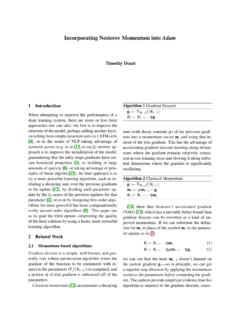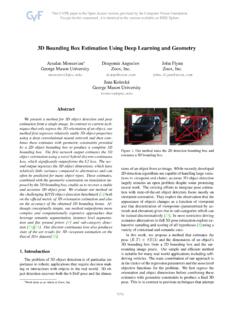Transcription of 3.5 Pendulum period - Massachusetts Institute of …
1 Pendulum period682009-02-10 19:40:05 UTC / rev periodIs it coincidence thatg, in units of meters per second squared, , veryclose to 2 Their proximity suggests a connection. Indeed, theyare connected through the original de nition of the meter. It was proposedby the the Dutch scientist and engineer Christian Huygens (science andengineering were not separated in the 17th century) called the most in-genious watchmaker of all time by the great physicist Arnold Sommerfeld[16, p. 79]. Huygens s portable de nition of the meter required only a pen-dulum clock: Adjust the bob s lengthluntil the Pendulum requires1s toswing from one side to the other; in other words, until its period isT= Pendulum s period (for small amplitudes) isT=2 pl/g, as shownbelow, sog=4 theT=2s standard for the meter,g=4 2x1m4s2= 2m s , if Huygens s standard were used today, thengwould be 2by de n-ition.
2 Instead, it is close to that value. The story behind the difference isrich in physics, mechanical and materials engineering, mathematics, andhistory; see [17,18,19] for several views of a vast and fascinating How is the time measured?Huygens s standard for the meter requires a way to measure time, and noquartz clocks were available. How could one, in the 17th century, ensure thatthe Pendulum s period is indeed2s?Here our subject is to nd how the period of a Pendulum depends onits amplitude. The analysis uses all our techniques so far dimensions(Chapter 1), easy cases (Chapter 2), and discretization (this chapter) tolearn as much as possible without solving differential 3.
3 Discretization692009-02-10 19:40:05 UTC / rev 4d4a39156f1eml Here is the differential equation for the motion of an ideal pen-dulum (one with no friction, a massless string, and a minisculebob):d2 dt2+glsin =0,where is the angle with respect to the vertical,gis the gravita-tional acceleration, andlis the mass of the of deriving this equation from physical principles (see [20] for aderivation), take it as a given but check that it makes its dimensions correct?It has only two terms, and they must have identical dimensions. For the rst term,d2 /dt2, the dimensions are the dimensions of divided by T2from thedt2.
4 (With apologies for the double usage, this T refers to the timedimension rather than to the period .) Since angles are dimensionless (seeProblem ), d2 dt2 =T the second term, the dimensions arehglsin i=hgli [sin ].Sincesin is dimensionless, the dimensions are just those ofg/l, whichare T 2. So the two terms have identical AnglesWhy are angles dimensionless?Problem Where did the mass go?Use dimensions to show that the differential equation cannot contain the massof the bob (except as a common factor that divides out).Because of the nonlinear factorsin , solving this differential equation isdif cult.
5 One can compute a power-series solution, and call the resultingin nite series a new function. That procedure, when applied to anotherdifferential equation, is the origin of the Bessel functions. However, theso-called elementary functions those built fromsin,cos,exp,ln, andpowers do not contain a solution to the Pendulum Pendulum period702009-02-10 19:40:05 UTC / rev 4d4a39156f1ecos sin 1unit circle So, use easy cases to simplify the source of the prob-lem, namely thesin factor. One easy case is the ex-treme case 0. To approximatesin in that limit,mark andsin on a quarter-section of the unit cir-cle.
6 By de nition, is the length of the arc. Also byde nition,sin is the altitude of the enclosed righttriangle. When is small, the arc is almost exactly thealtitude. Therefore, for small :sin .It is a tremendously useful Slightly better approximationThe preceding approximation replaced the arc with a straight, vertical line. Amore accurate approximation replaces the arc with the chord (a straight butnon-vertical line). What is the resulting approximation forsin , includingthe 3term?In this small- extreme, the Pendulum equation turns intod2 dt2+gl = looks like the ideal-spring differential equation analyzed inSection :d2xdt2+kmx=0,wheremis the mass andkis the spring constant (the stiffness).
7 Comparingthe two equations produces this correspondence:x ;km the oscillation period for the ideal spring isT=2 rmk,the oscillation period for the Pendulum , in the 0limit, isT=2 3. Discretization712009-02-10 19:40:05 UTC / rev 4d4a39156f1eDoes this period have correct dimensions?Pause to sanity check this result by asking: Is each portion of the formulareasonable, or does it come out of left eld. [For non-American readers,left eld is one of the distant reaches of a baseball eld. To come out ofleft elds means an idea comes almost out of nowhere, surprising all withits craziness.]
8 ] The rst sanity check is dimensions. They are correct in theapproximate spring differential equation; but let s also check the dimen-sions of the periodT=2 pl/gthat results from solving the equation. Inthe symbolic factorpl/g, the lengths cancel and leave only T2inside thesquare root. Sopl/gis a time as it should about easy cases?Another sanity check is easy cases. For example, imagine a huge gravita-tional eld strengthg. Then gravity easily and rapidly swings the bob toand fro, making the period tiny. Sogshould live in the denominator ofT and it Another easy case?
9 Can you use easy cases to explain whylbelongs in the numerator?Didn t the2 come from solving differential equations, contrary to the earlierpromise to avoid solving differential equations?The dimensions and easy-cases tests con rm thepl/gfactor. But how toexplain the remaining piece: the numerical factor of2 that arose from thesolution to the ideal-spring differential equation. However, we want toavoid solving differential equations. Can our techniques derive the2 ? amplitudes and Huygens methodml Dimensions and easy cases rarely explain a dimension-less constant.
10 Therefore explaining the factor of2 prob-ably requires a new idea. It too is due to Huygens. Hisidea [16, p. 79ff] is to analyze the motion of a conicalpendulum: a Pendulum moving in a horizontal its motion is two dimensional, it is at constantspeed, so it is easy to analyze without solving differen-tial Pendulum period722009-02-10 19:40:05 UTC / rev 4d4a39156f1eEven if the analysis of the conical Pendulum is simple, how is it relevant to themotion of a one-dimensional Pendulum ?Projecting the two-dimensional motion onto a screen produces one-dimensionalpendulum motion, so the period of the two-dimensional motion is the sameas the period of the one-dimensional motion!
















